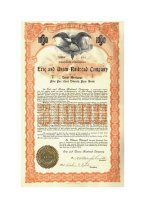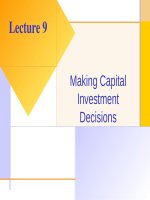Lecture Essentials of corporate finance (2/e) – Chap 5: Discounted cash flow valuation
Bạn đang xem bản rút gọn của tài liệu. Xem và tải ngay bản đầy đủ của tài liệu tại đây (670.02 KB, 86 trang )
Discounted cash flow
valuation
Chapter 5
Key concepts and skills
• Be able to compute the future value of
multiple cash flows
• Be able to compute the present value of
multiple cash flows
• Be able to compute loan payments
• Be able to find the interest rate on a loan
• Understand how loans are amortised or
paid off
• Understand how interest rates are quoted
Copyright © 2011 McGraw-Hill Australia Pty Ltd
PPTs t/a Essentials of Corporate Finance 2e by Ross et al.
Slides prepared by David E. Allen and Abhay K. Singh
5-2
Chapter outline
• Future and present values of multiple
cash flows
• Valuing level cash flows: Annuities and
perpetuities
• Comparing rates: The effect of
compounding periods
• Loan types and loan amortisation
Copyright ©2011 McGraw-Hill Australia Pty Ltd
PPTs t/a Essentials of Corporate Finance 2e by Ross et al.
Slides prepared by David E. Allen and Abhay K. Singh
5-3
Future value with multiple cash
flows—Drawing and using a time line
• Suppose you deposit $100 today in an account
paying 8%. In one year, you will deposit another
$100. How much will you have in two years?
– At the end of first year = 100* (1.08)+100=208
– At the end of second year = 208*(1.08)=224.64
Copyright ©2011 McGraw-Hill Australia Pty Ltd
PPTs t/a Essentials of Corporate Finance 2e by Ross et al.
Slides prepared by David E. Allen and Abhay K. Singh
5-4
Future value: Multiple cash flows
Example 5.1
• You think you will be able to deposit
$4000 at the end of each of the next 3
years in a bank account paying 8%
interest.
• You currently have $7000 in the
account.
• How much will you have in 3 years?
• How much in 4 years?
Copyright © 2011 McGraw-Hill Australia Pty Ltd
PPTs t/a Essentials of Corporate Finance 2e by Ross et al.
Slides prepared by David E. Allen and Abhay K. Singh
5-5
Future value: Multiple cash
flows Example 5.1—Formulas
• Find the value at year 3 of each cash
flow and add them together
–
–
–
–
–
Year 0: FV = $7000(1.08)3
Year 1: FV = $4000(1.08)2
Year 2: FV = $4000(1.08)1
Year 3: value
Total value in 3 years
= $ 8 817.98
= $ 4 665.60
= $ 4 320.00
= $ 4 000.00
= $21 803.58
• Value at year 4 = $21 803.58(1.08)= $23 547.87
Copyright © 2011 McGraw-Hill Australia Pty Ltd
PPTs t/a Essentials of Corporate Finance 2e by Ross et al.
Slides prepared by David E. Allen and Abhay K. Singh
5-6
Future value: Multiple cash
flows Example 5.1—Calculator
• Calculator keys:
– Today (year 0 CF): 3 N; 8 I/Y; -7000 PV; CPT
FV = 8817.98
– Year 1 CF: 2 N; 8 I/Y; -4000 PV; CPT FV =
4665.60
– Year 2 CF: 1 N; 8 I/Y; -4000 PV; CPT FV =
4320
– Year 3 CF: value = 4000
– Total value in 3 years = 8817.98 + 4665.60 +
4320 + 4000 = 21 803.58
• Value at year 4: 1 N; 8 I/Y; -21 803.58 PV;
5-7
CPT FV = 23 547.87
Copyright © 2011 McGraw-Hill Australia Pty Ltd
PPTs t/a Essentials of Corporate Finance 2e by Ross et al.
Slides prepared by David E. Allen and Abhay K. Singh
Future value: Multiple cash
flows Example 5.2
• You deposit $100 in one year, $200 in
two years and $300 in three years.
• How much will you have in 3 years at
7% interest?
– Year 1: FV = $100(1.07)2 = $ 114.49
– Year 2: FV = $200(1.07) = $ 214.00
– Year 3: FV = $300
– Total value in 3 years
Copyright © 2011 McGraw-Hill Australia Pty Ltd
PPTs t/a Essentials of Corporate Finance 2e by Ross et al.
Slides prepared by David E. Allen and Abhay K. Singh
= $ 300.00
= $628.49
5-8
Future value: Multiple cash
flows Example 5.2 (cont.)
• How much in 5 years if you don’t add
additional amounts?
– Amount in three years = 628.49
– Year 5: FV=628.49(1.07)2 = $719.56
– This can also be calculated by calculating the
future value of each amount separately.
– Year 1: FV= 100(1.07)4 = 131.08
– Year 2: FV= 200(1.07)3 = 245.01
– Year 3: FV=300(1.07)2 = 343.47
– Total = 719.56
Copyright © 2011 McGraw-Hill Australia Pty Ltd
PPTs t/a Essentials of Corporate Finance 2e by Ross et al.
Slides prepared by David E. Allen and Abhay K. Singh
5-9
Future value: Multiple cash
flows Example 5.2—Formulas and
time line
TIMELINE
0
1
2
3
4
-$100.00
-$200.00
-$300.00
5
7%
$300.00
200*(1.07) =
$214.00
100*(1.07)^2 =
$114.49
$628.49
Total interest = $628.49-600=28.49
* (1.07)^2 =
Copyright © 2011 McGraw-Hill Australia Pty Ltd
PPTs t/a Essentials of Corporate Finance 2e by Ross et al.
Slides prepared by David E. Allen and Abhay K. Singh
$719.56
5-10
Future value: Multiple cash
flows Example 5.2 (cont.)
• Calculator keys:
– Year 1 CF: 2 N; 7 I/Y; -100 PV; CPT FV =
114.49
– Year 2 CF: 1 N; 7 I/Y; -200 PV; CPT FV =
214.00
– Year 3 CF: value = 300
– Total value in 3 years =
114.49+214.00+300.00 = 628.49
– Total FV in 5 years = 628.49*(1.07)2 =
Copyright
© 2011 McGraw-Hill Australia Pty Ltd
719.56
PPTs t/a Essentials of Corporate Finance 2e by Ross et al.
5-11
Slides prepared by David E. Allen and Abhay K. Singh
Future value: Multiple cash
flows:
Another example
• Suppose you plan to deposit $100 into an
account in one year and $300 into the
account in 3 years. How much will be in
the account in 5 years if the interest rate is
8%?
– FV = 100(1.08)4 + 300(1.08)2 = 136.05 +
349.92 = $485.97
• Calculator keys:
– Year 1 CF: 4 N; -100 PV; 8 I/Y; CPT FV =
136.05
– Year 3 CF: 2 N; -300 PV; 8 I/Y; CPT FV =
Copyright © 2011 McGraw-Hill Australia Pty Ltd
PPTs349.92
t/a Essentials of Corporate Finance 2e by Ross et al.
Slides prepared by David E. Allen and Abhay K. Singh
5-12
Example—Time line
0
1
100
2
3
4
5
300
136.05
349.92
$485.97
Copyright © 2011 McGraw-Hill Australia Pty Ltd
PPTs t/a Essentials of Corporate Finance 2e by Ross et al.
Slides prepared by David E. Allen and Abhay K. Singh
5-13
Present value: Multiple cash
flows
Example 5.3
You are offered an investment that will
pay:
– $200 in year 1;
– $400 the next year;
– $600 the following year; and
– $800 at the end of the 4th year.
You can earn 12% on similar
investments. What is the most you
should pay for this one?
Copyright © 2011 McGraw-Hill Australia Pty Ltd
PPTs t/a Essentials of Corporate Finance 2e by Ross et al.
Slides prepared by David E. Allen and Abhay K. Singh
5-14
Present value: Multiple cash
flows
Example 5.3—Formula
Find the PV of each cash flow and add
them:
– Year 1 CF: $200 / (1.12)1 = $ 178.57
– Year 2 CF: $400 / (1.12)2 = $ 318.88
– Year 3 CF: $600 / (1.12)3 = $ 427.07
– Year 4 CF: $800 / (1.12)4 = $ 508.41
– Total PV
Copyright © 2011 McGraw-Hill Australia Pty Ltd
PPTs t/a Essentials of Corporate Finance 2e by Ross et al.
Slides prepared by David E. Allen and Abhay K. Singh
= $1432.93
5-15
Present value: Multiple cash
flows
Example 5.3—Calculator
• Calculator:
– Year 1 CF: N = 1; I/Y = 12; FV = 200; CPT PV
= -178.57
– Year 2 CF: N = 2; I/Y = 12; FV = 400; CPT PV
= -318.88
– Year 3 CF: N = 3; I/Y = 12; FV = 600; CPT PV
= -427.07
– Year 4 CF: N = 4; I/Y = 12; FV = 800; CPT PV
= - 508.41
– Total PV = 178.57 + 318.88 + 427.07 +
508.41 = 1432.93
Copyright © 2011 McGraw-Hill Australia Pty Ltd
PPTs t/a Essentials of Corporate Finance 2e by Ross et al.
Slides prepared by David E. Allen and Abhay K. Singh
5-16
Present value: Multiple cash
flows
0
Example 5.3—Time line
1
2
3
4
Time
(years)
200
400
600
800
178.57
318.88
427.07
508.41
= 1/(1.12)2 x
= 1/(1.12)3 x
= 1/(1.12)4 x
1,432.93
Copyright © 2011 McGraw-Hill Australia Pty Ltd
PPTs t/a Essentials of Corporate Finance 2e by Ross et al.
Slides prepared by David E. Allen and Abhay K. Singh
5-17
Present value: Multiple cash
flows
Example 5.4
You are offered an investment that will
pay:
– 3 payments of $5000
• the first $5000 in four years from today
• the second $5000 in five years
• the third $5000 in six years
You can earn 11%.
What is the future value of cash flows?
Copyright © 2011 McGraw-Hill Australia Pty Ltd
PPTs t/a Essentials of Corporate Finance 2e by Ross et al.
Slides prepared by David E. Allen and Abhay K. Singh
5-18
Present value: Multiple cash
flows
Example 5.4 (cont.)
• First method:
–
–
–
–
–
Year 4: FV= 5000(1.11)2
Year 5: FV= 5000(1.11)
Year 6: Value
Total
PV = 16710.50/(1.11)6
=6160.50
=5550
=5000
=16710.50
=8934.12
• Second method—using PV one at a time:
–
–
–
–
Year 6: CF: 5000/(1.11)6
Year 5: CF: 5000/(1.11)5
Year 4: CF: 5000/(1.11)4
Total PV
Copyright © 2011 McGraw-Hill Australia Pty Ltd
PPTs t/a Essentials of Corporate Finance 2e by Ross et al.
Slides prepared by David E. Allen and Abhay K. Singh
=2673.20
=2967.26
=3293.65
=8934.12
5-19
Present value: Multiple cash
flows
Another example—Formula solution
• You are considering an investment that
will pay you $1000 in one year, $2000
in two years and $3000 in three years.
If you want to earn 10% on your
money, how much would you be willing
to pay?
PV = $1,000 / (1.1)1
= $ 909.09
PV = $2,000 / (1.1)2
= $1652.89
PV = $3,000 / (1.1)3
= $2253.94
PV
= $4815.92
Copyright © 2011 McGraw-Hill Australia Pty Ltd
PPTs t/a Essentials of Corporate Finance 2e by Ross et al.
Slides prepared by David E. Allen and Abhay K. Singh
5-20
Present value: Multiple cash
flows
Another example—Calculator solution
• Calculator:
– N = 1; I/Y = 10; FV = 1000; CPT PV =
-909.09
– N = 2; I/Y = 10; FV = 2000; CPT PV =
-1652.89
– N = 3; I/Y = 10; FV = 3000; CPT PV =
-2253.94
– Total PV= $4815.92
Copyright © 2011 McGraw-Hill Australia Pty Ltd
PPTs t/a Essentials of Corporate Finance 2e by Ross et al.
Slides prepared by David E. Allen and Abhay K. Singh
5-21
Calculator hints
• Use the internal memory of the
calculator to store cash flows.
• Use of cash flow or CF key
– Clear all
• [CF]-[2nd]-[CLR WORK]
– Enter period 0 cash flow (use [+/-] to
change the sign)
– Press [ENTER] to enter the figure in cash
flow register
Copyright © 2011 McGraw-Hill Australia Pty Ltd
PPTs t/a Essentials of Corporate Finance 2e by Ross et al.
Slides prepared by David E. Allen and Abhay K. Singh
5-22
Example: Spreadsheet
strategies
• You can use the PV or FV functions in
Excel to find the present value or future
value of a set of cash flows.
• Setting the data up is half the battle—
once it is set up properly, you can simply
copy the formulas.
• Click on the Excel icon for an example.
Copyright © 2011 McGraw-Hill Australia Pty Ltd
PPTs t/a Essentials of Corporate Finance 2e by Ross et al.
Slides prepared by David E. Allen and Abhay K. Singh
5-23
Decisions, decisions…
•
Your broker calls you and tells you that he has a great
investment opportunity for you. If you invest $100 today, you
will receive $40 in one year and $75 in two years. If you require
a 15% return on investments of this risk, should you take the
investment?
– Use the CF keys to compute the value of
the investment:
• CF; CF0 = 0; C01 = 40; F01 = 1; C02 = 75; F02 = 1
• NPV; I = 15; CPT NPV = $91.49
– No: the broker is charging more than you
would be willing to pay.
Copyright © 2011 McGraw-Hill Australia Pty Ltd
PPTs t/a Essentials of Corporate Finance 2e by Ross et al.
Slides prepared by David E. Allen and Abhay K. Singh
5-24
Saving for retirement
• You are offered the opportunity to put
some money away for retirement. You
will receive 5 annual payments of $25
000 each, beginning in 40 years. How
much would you be willing to invest
today if you desire an interest rate of
12%?
– Use cash flow keys:
• CF; CF0 = 0; C01 = 0; F01 = 39; C02 = 25000;
CopyrightF02
© 2011 McGraw-Hill
Australia
Pty12;
Ltd CPT NPV = $1084.71
=
5;
NPV;
I
=
PPTs t/a Essentials of Corporate Finance 2e by Ross et al.
5-25
Slides prepared by David E. Allen and Abhay K. Singh









